Discover the 19 Largest Flying Birds in Louisiana
Louisiana is a paradise for birdwatchers and nature enthusiasts. There are more than 450 known bird species in the state. From the sleek Great Blue Heron to the strong Bald Eagle, Louisiana’s skies are truly alive. Some of the flying birds in Louisiana are truly massive.
In this article, we will take a look at 19 of the largest flying birds in Louisiana, examining some spectacular avian giants.
1. American White Pelican (Pelecanus erythrorhynchos) — 60 to 63 inches
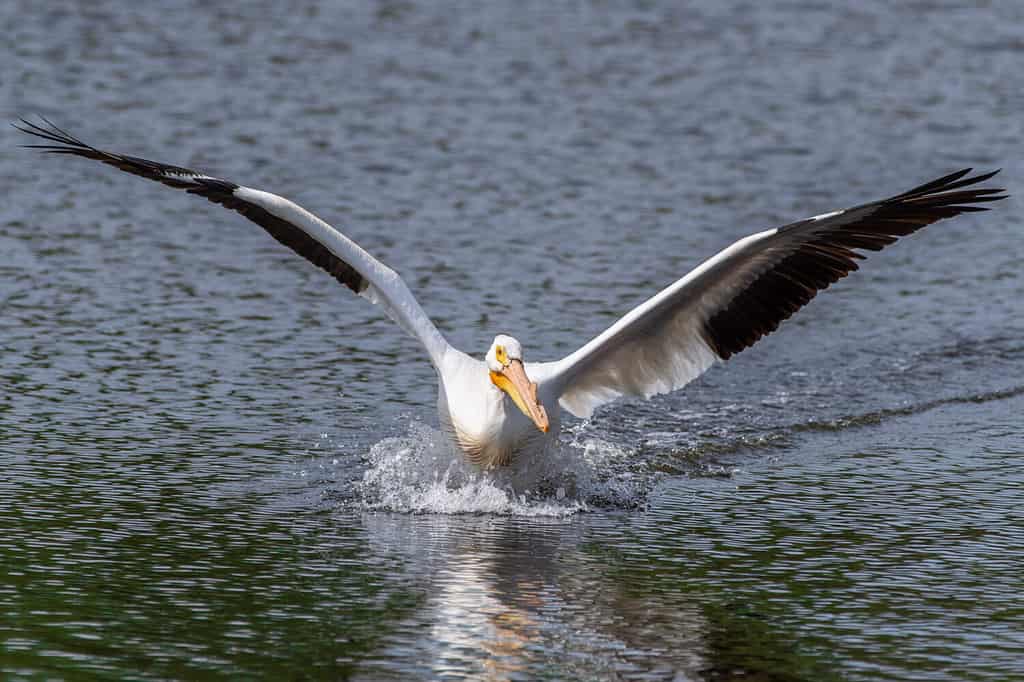
©Mike Lynds/Shutterstock.com
| Measurement | Size |
|---|---|
| Length | 60 – 63 in (152 – 160 cm) |
| Weight | 15.5 pounds (7 kg) |
| Wingspan | 96 – 110 in (244 – 279 cm) |
American white pelicans are huge sea birds. While they aren’t the heaviest bird in Louisiana, they are the largest when considering their wingspan. The white pelican’s wingspan is second only to the California condor among North American birds. These birds are covered in bright white feathers, which is the best way to identify them from other pelican species. During the breeding season, they even get a yellow plate on their beaks. American white pelicans hang out in shallow lakes and wet areas, but in winter, they head to the coast. What’s their favorite food? Fish! Pelicans hover over water bodies, and when they spot a fish, they quickly dive down and scoop them up with their large bills.
2. Mute Swan (Cygnus olor) — 56 to 62 inches

©Arte foto/Shutterstock.com
| Measurement | Size |
|---|---|
| Length | 56 – 62 in (142 – 157 cm) |
| Weight | 26 pounds (11789 g) |
| Wingspan | 84 – 96 in (213 – 244 cm) |
Mute swans are large, long-necked birds. These flying birds are not originally from Louisiana, as they are native to Eurasia, but they are now a popular sight in the southeast. They are the heaviest flying birds in Louisiana, with males weighing more than 25 pounds! Interestingly, mute swans were originally brought to the US to decorate parks and lakes, as they are a beautiful species. They mostly love city parks, lakes, and wet places. Mute swans are omnivores, but they almost exclusively eat water plants and algae.
Fun fact: they’re super protective parents. If they feel their babies are threatened, they’ll hiss loudly, almost like a warning, before they might even attack. It’s their way of saying, “Stay away from my family!”
3. Whooping Crane (Grus americana) — 52 inches
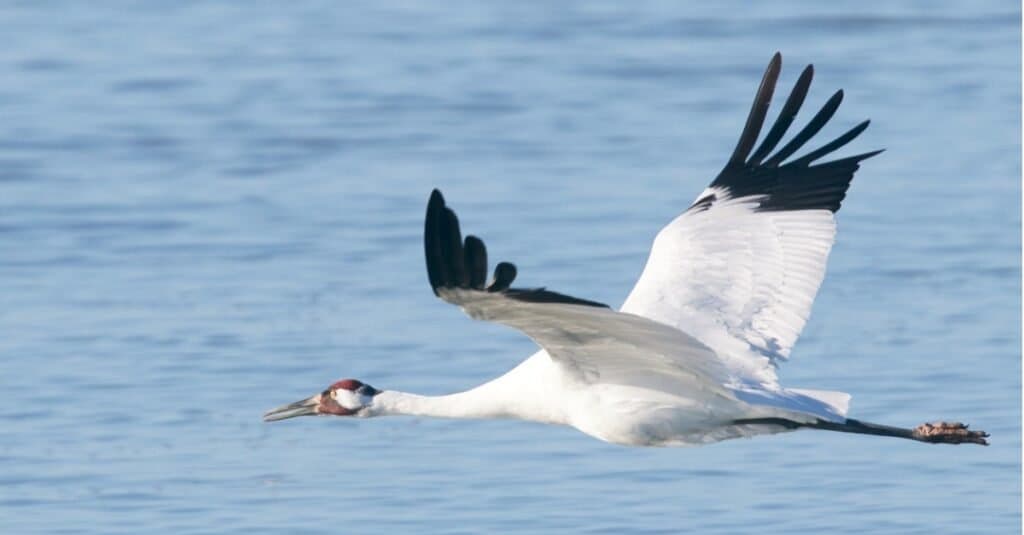
©iStock.com/kellington1
| Measurement | Size |
|---|---|
| Length | 52 to 60 in (152 cm) |
| Weight | 10 to 20 pounds (8.6 kg) |
| Wingspan | 87 in (221 cm) |
Whooping cranes are stunning white birds known for their amazing dances and loud calls. They’re easily spotted with a red crown and black face. Interestingly, when they fly, you can see some hidden black feathers. These birds almost vanished in the 1940s, having only 20 left. Thankfully, through hard conservation work, their numbers now stand at around 600. When they find a partner, they dance gracefully, truly showing off their vibrant yet calm side. This rare bird, once nearly lost, is a testament to the power of caring and effort in the world of nature conservation. Additionally, these birds migrate more than 2,400 miles each year from Canada to the Gulf Coast!
4. Great Blue Heron (Ardea herodias) — 46 to 52 inches
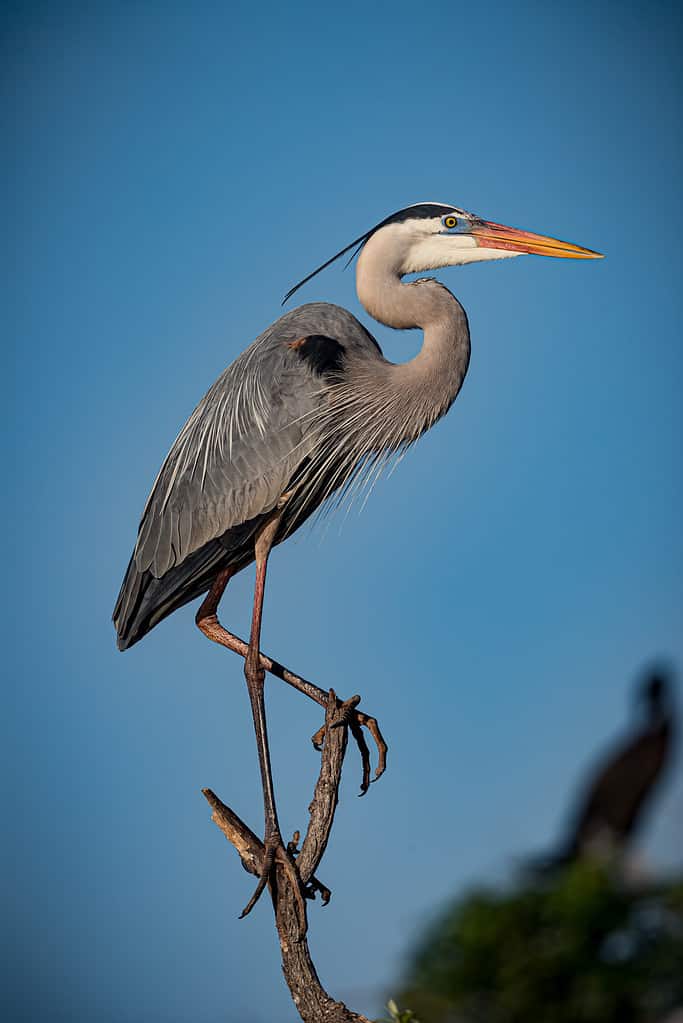
©jo Crebbin/Shutterstock.com
| Measurement | Size |
|---|---|
| Length | 46 – 52 in (117 – 132 cm) |
| Weight | 4 to 5.5 pounds (3 kg) |
| Wingspan | 77 – 82 in (196 – 208 cm) |
Great blue herons, large and graceful, stand out with their pale gray bodies and unique white faces, highlighted by a black crest extending backward. With a striking yellow-orange bill and an elegantly long neck featuring black streaks, they truly capture attention. These birds often stand alone near water, patiently waiting to catch fish or other small water creatures. Their focused and still hunting style, combined with their majestic appearance, makes them a fascinating sight in North America’s water habitats. Great blue herons stand at up to 4 feet tall, making them one of the largest flying birds in Louisiana. These are a common sight in the state and can be found in almost any wet space or waterway.
5. Brown Pelican (Pelecanus occidentalis) — 48 to 50 inches
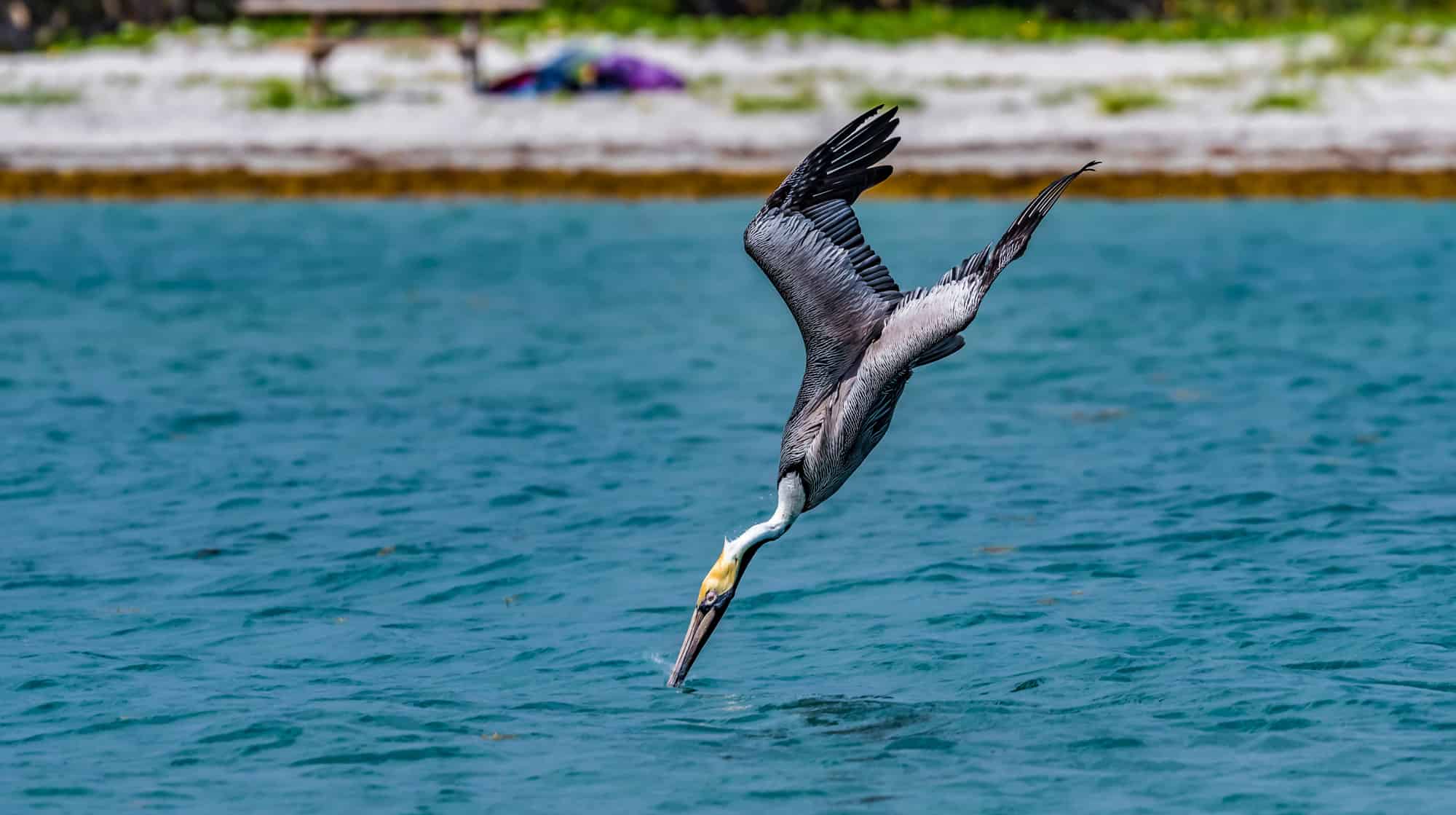
©mark smith nsb/Shutterstock.com
| Measurement | Size |
|---|---|
| Length | 48 – 50 in (122 – 127 cm) |
| Weight | 7 pounds (3 kg) |
| Wingspan | 78 – 84 in (198 – 213 cm) |
You can easily spot brown pelicans on the Gulf Coast of Louisiana. With their big bills and brown bodies, brown pelicans have a massive wingspan. These birds, living near water, are known for their impressive diving skills. They soar high and then dramatically dive to catch fish, their main food. This unique and eye-catching way of hunting makes them interesting to watch and a symbol of coastal life.
6. Wild Turkey (Meleagris gallopavo) — 43.3 to 45.3 inches

©Jim Cumming/Shutterstock.com
| Measurement | Size |
|---|---|
| Length | 43.3 – 45.3 in (110 – 115 cm) |
| Weight | 6 to 24 pounds (10.8 kg) |
| Wingspan | 49.2 – 56.7 in (125 – 144 cm) |
While turkeys are generally thought of as flightless, they can, in fact, fly. That said, these massive birds are lazy and don’t tend to fly for long distances. Wild turkeys are the ancestors to the domestic turkeys you eat on Thanksgiving. These are very big birds with round bodies weighing up to 24 pounds! Males have colorful red-and-blue heads with unique growths called caruncles and a hanging snood on their bill. Their tails fan out and are mixed with shiny colors, while females are more subdued in appearance. These birds live in forests, loving areas with both trees and open spaces. They are omnivores, eating things they find on the ground, like acorns, berries, and small bugs. During mating season, males put on vibrant displays, showcasing their colors and feathers, to impress the females.
7. Great Egret (Ardea alba) — 37 to 41 inches
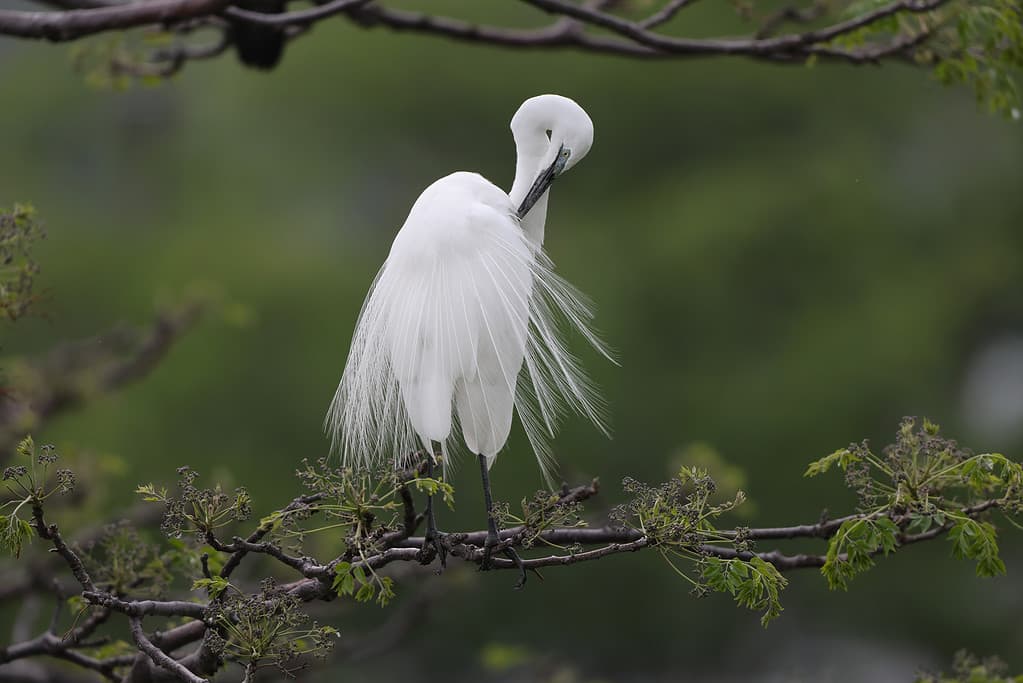
©feathercollector/iStock via Getty Images
| Measurement | Size |
|---|---|
| Length | 37 – 41 in (94 – 104 cm) |
| Weight | 1.5 to 3.3 pounds(1.5 kg) |
| Wingspan | 54 – 55 in (137 – 140 cm) |
The great egret is a large flying bird in Louisiana that is known for its stunning long white feathers. This bird almost disappeared due to overhunting in the late 1800s. Hunters harvested the feathers for the fashion industry, which is called “plume hunting”. Plume hunting was banned in the early 20th century, and the great egret population has since bounced back. These elegant birds have long necks, a yellow bill, and black legs. They typically hang out near water, skillfully hunting for fish and small creatures. Louisiana’s habitats perfectly showcase these birds, and it’s amazing to think that they once nearly vanished because of fashion trends.
8. Wood Stork (Mycteria americana) — 35 to 45 inches
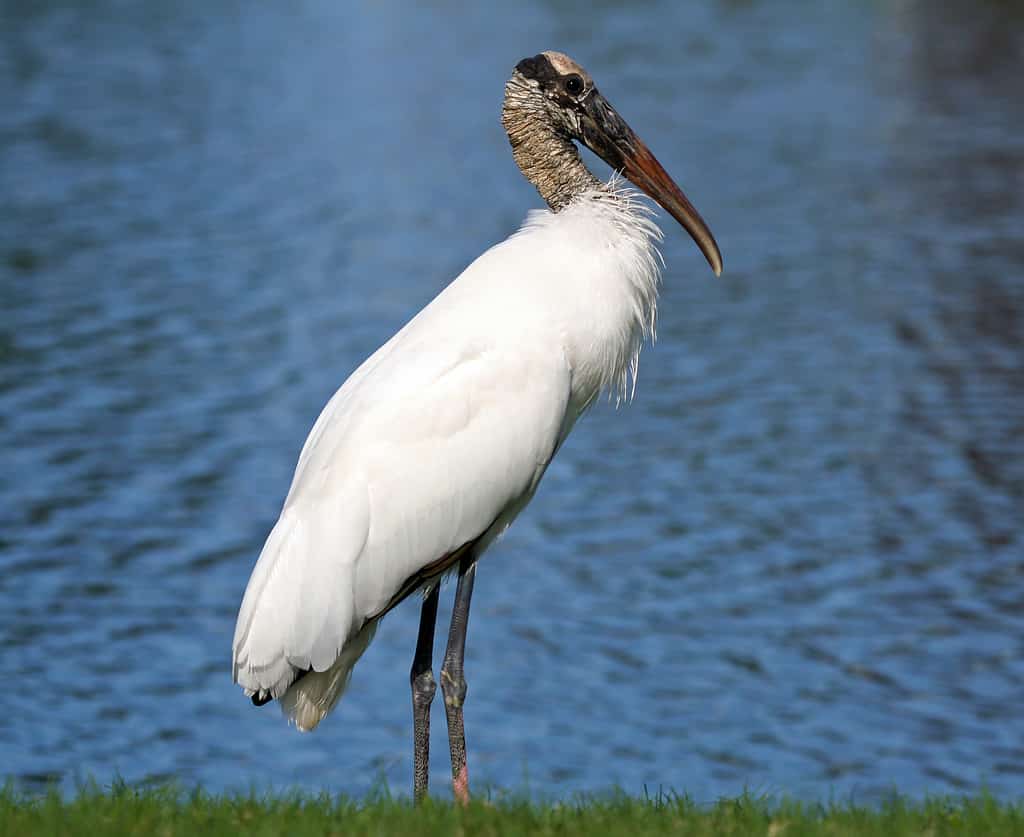
© Googie man at en.wikipedia / CC BY-SA 3.0 – License
| Measurement | Size |
|---|---|
| Length | 35 – 45 in (89 – 114 cm) |
| Weight | 4 to 6 pounds (2.7 kg) |
| Wingspan | 65 in (165 cm) |
Wood storks, sometimes called “wood ibis,” are large birds found across the Americas. They have a unique bald head and a long bill. These birds primarily live in wet places like swamps, where they slowly search for fish, their favorite food. They have an incredible way of finding food: they wade in the water with an open bill and snap it shut when they feel a fish. It’s also neat to see their nests, often built high in trees above standing water. It’s like they’ve built a treetop neighborhood!
9. Sandhill Crane (Antigone canadensis) — 34 to 48 inches
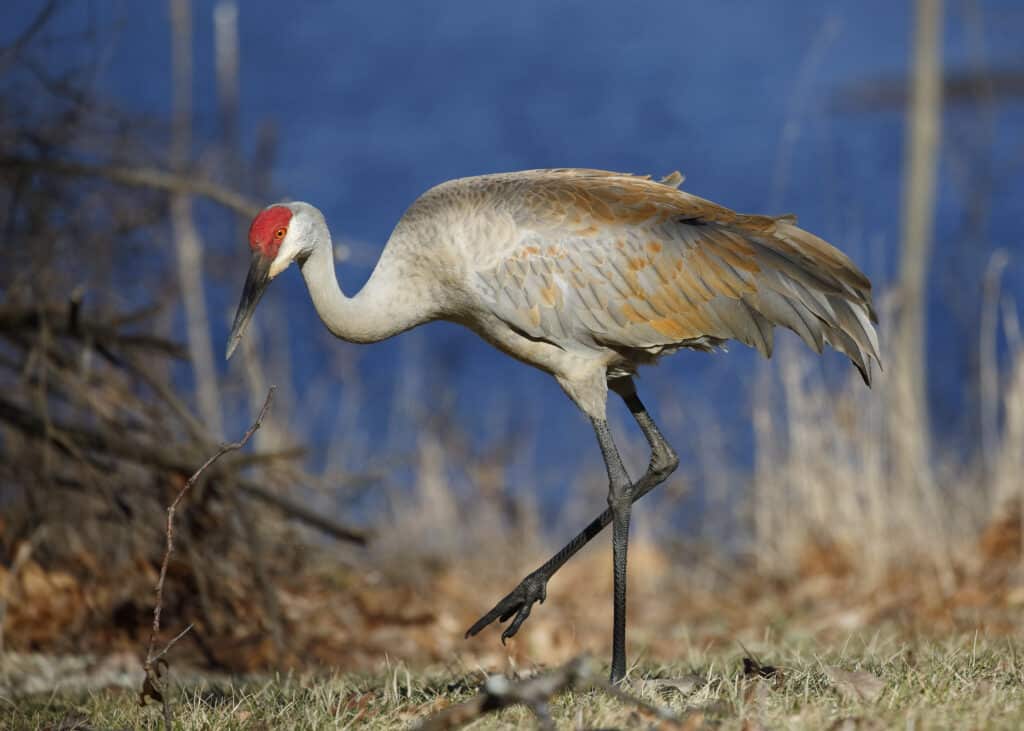
©Brian Lasenby/Shutterstock.com
| Measurement | Size |
|---|---|
| Length | 34 – 48 in (86 – 122 cm) |
| Weight | 7 to 11 pounds (5 kg) |
| Wingspan | 73 – 90 in (185 – 229 cm) |
Sandhill cranes are tall, gray birds that visit Louisiana in winter, specifically from October to April. They’re large and heavy birds that have a noticeable bright red crown and white face. With their long legs and bills, plus their striking looks, they’re a sight to see! They typically stick around Louisiana until spring before heading north for the summer. So there’s a good chance to spot them during those months.
10. Bald Eagle (Haliaeetus leucocephalus) — 34 to 43 inches
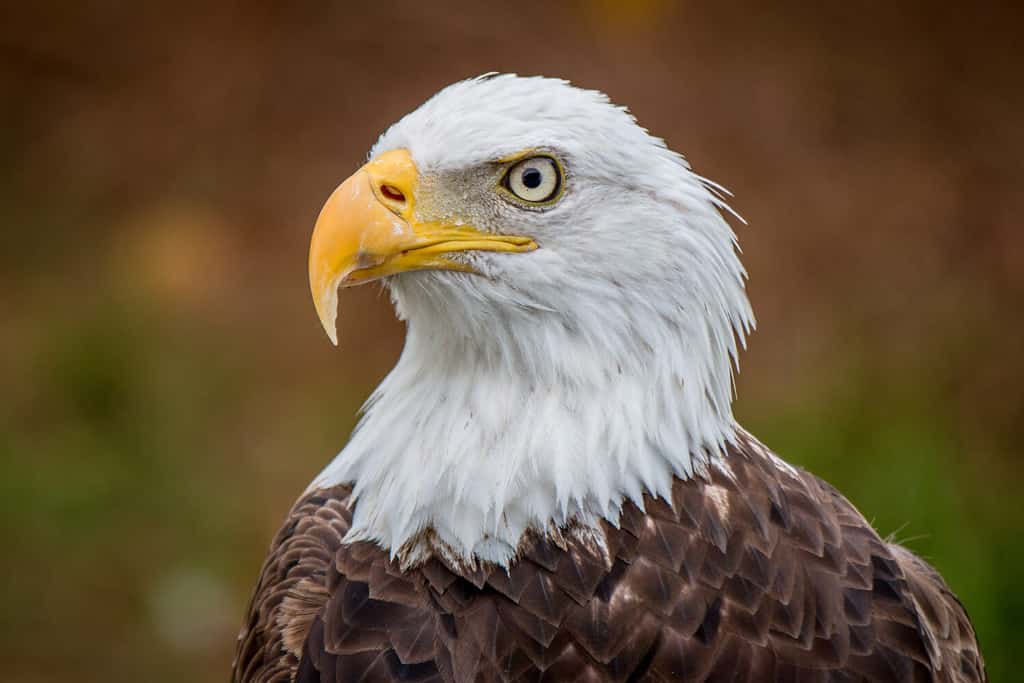
©Kevin Tubbergen/Shutterstock.com
| Measurement | Size |
|---|---|
| Length | 34 – 43 in (86 – 109 cm) |
| Weight | 6 to 14 pounds (6.3 kg) |
| Wingspan | 72 – 96 in (183 – 244 cm) |
The bald eagle is the national bird of the USA and is easily the most iconic bird in the country, let alone Louisiana. With white heads, huge wingspans, and large talons, bald eagles are really easy to spot. These are predatory birds equipped with giant sharp talons, around than 2 inches long. Females look exactly like males but are a bit bigger, by about 25%.
Fun fact: Bald eagles have a grip force that is 10 times stronger than the average adult human!
11. Golden Eagle (Aquila chrysaetos) — 27 to 38 inches
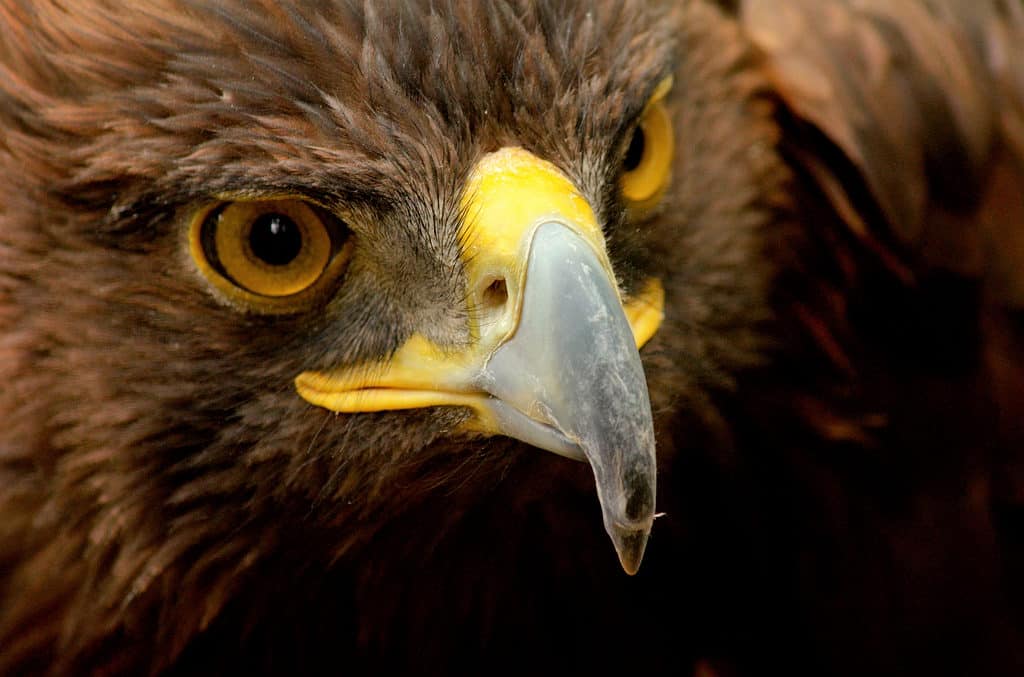
©iStock.com/Paco Adame
| Measurement | Size |
|---|---|
| Length | 27 – 38 in (69 – 97 cm) |
| Weight | 6 to 15 pounds (6.8 kg) |
| Wingspan | 72 – 96 in (183 – 244 cm) |
Golden eagles are another spectacular eagle species in Louisiana. They are birds of prey with a huge wingspans. With their unique golden-brown crown, you won’t often see them in Louisiana. However, people occasionally spot them in places like Richland and White Lake Wetlands Conservation Area.
Fun fact: They’re the most common and widely distributed eagle species found all over the world. So, while they may be rare here, they’re famous globally!
12. Canada Goose (Branta canadensis) — 25 to 45 inches

©Charlotte Evelyn/Shutterstock.com
| Measurement | Size |
|---|---|
| Length | 25 – 45 in (64 – 114 cm) |
| Weight | 6 to 14 pounds (6.3 kg) |
| Wingspan | 70 – 75 in (178 – 190 cm) |
Canada geese are one of the largest non-migratory birds you can see in Louisiana all year round. However, they are especially prevalent in winter. They have an extremely recognizable black head with a white strap under their chin. Additionally, Canada geese make a loud honking sound that’s hard to miss. With their long necks and wide wings, they’re a pretty big deal around here! So, when you hear that honk, look up; you might see one of the most famous geese in the world!
13. Turkey Vulture (Cathartes aura) – 26 to 32 inches

©hubert999/Shutterstock.com
| Measurement | Size |
|---|---|
| Length | 26 – 32 in (66 – 81 cm) |
| Weight | 2 to 3.3 pounds (1.4 kg) |
| Wingspan | 68 – 72 in (173 – 183 cm) |
Turkey vultures are large, soaring birds with bald red heads and dark bodies. They have wide wings, around 68 to 72 inches wide, which they use to fly smoothly. Unlike other birds, they mainly eat dead and decaying animals(called carrion) they find lying around. So, if you see one hovering over open fields or roads, it’s probably spotted a meal! They’re super important for our environment since they clean up and stop diseases from spreading. They’re like nature’s cleanup crew!
14. Black Vulture (Coragyps atratus) — 23 to 27 inches

©Holly Guerrio/Shutterstock.com
| Measurement | Size |
|---|---|
| Length | 23 – 27 in (58 – 69 cm) |
| Weight | 2.6 to 4.5 pounds (2 kg) |
| Wingspan | 54 – 60 in (137 – 152 cm) |
Black vultures are another large bird that are commonly found in Louisiana. These dark-feathered birds are a bit smaller than their cousins, the turkey vultures. They have a wingspan of about 54 to 60 inches, perfect for gliding in the sky. While mostly eating carion, they’re not picky and might even snack on small (living) mammals, birds, or reptiles.
You’ll often see them hanging out together in open areas, trees, or even on fences, probably because they’re more social and tight-knit than turkey vultures. These birds stick close to family, with young ones staying with their parents for up to 8 months.
15. Crested Caracara (Caracara cheriway) — 20 to 25 inches
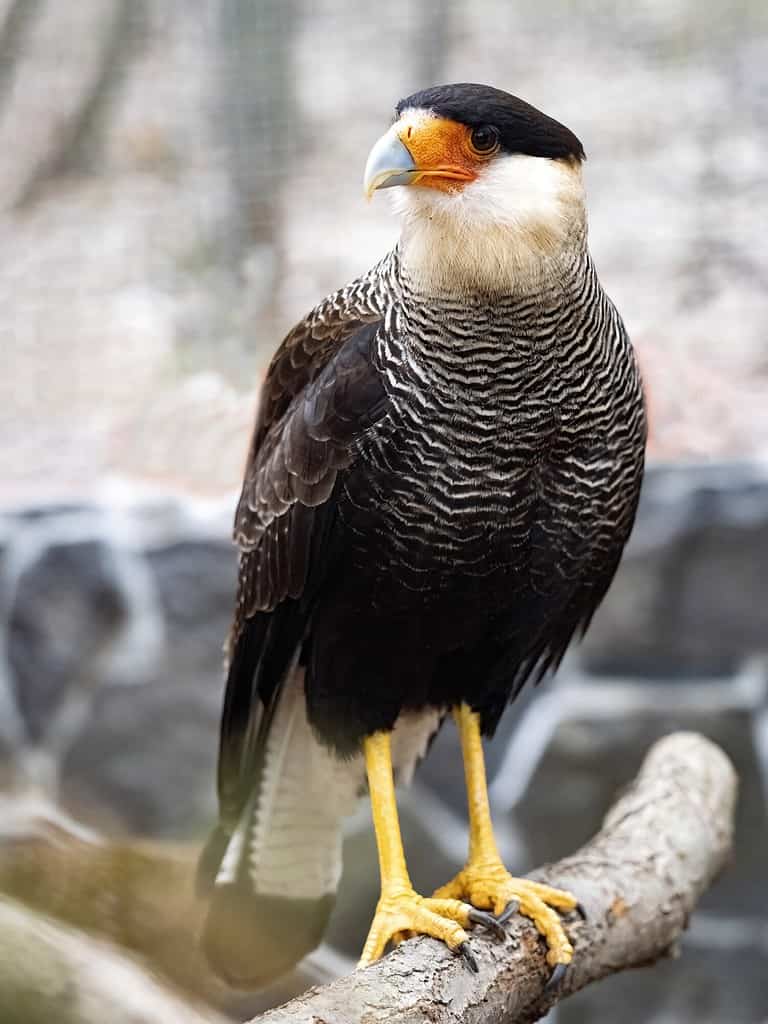
©Vladislav T. Jirousek/Shutterstock.com
| Measurement | Size |
|---|---|
| Length | 20 – 25 in (51 – 64 cm) |
| Weight | 2 to 3.5 pounds (1.6 kg) |
| Wingspan | 45 – 48 in (114 – 122 cm) |
Crested caracaras are large, dark falcons with unique flat heads, black scruffy crowns, and a bright orange beak. Mainly living in open spaces like prairies, they’re super adaptable eaters, eating everything from dead animals, insects, small mammals, and even fish! Interestingly, while many falcon species take over other birds’ nests, crested caracars actually make their own. IYou can regularly spot these incredible birds in southwest Louisiana, adding a special touch to the local bird scene.
16. Osprey (Pandion haliaetus) — 21 to 24 inches
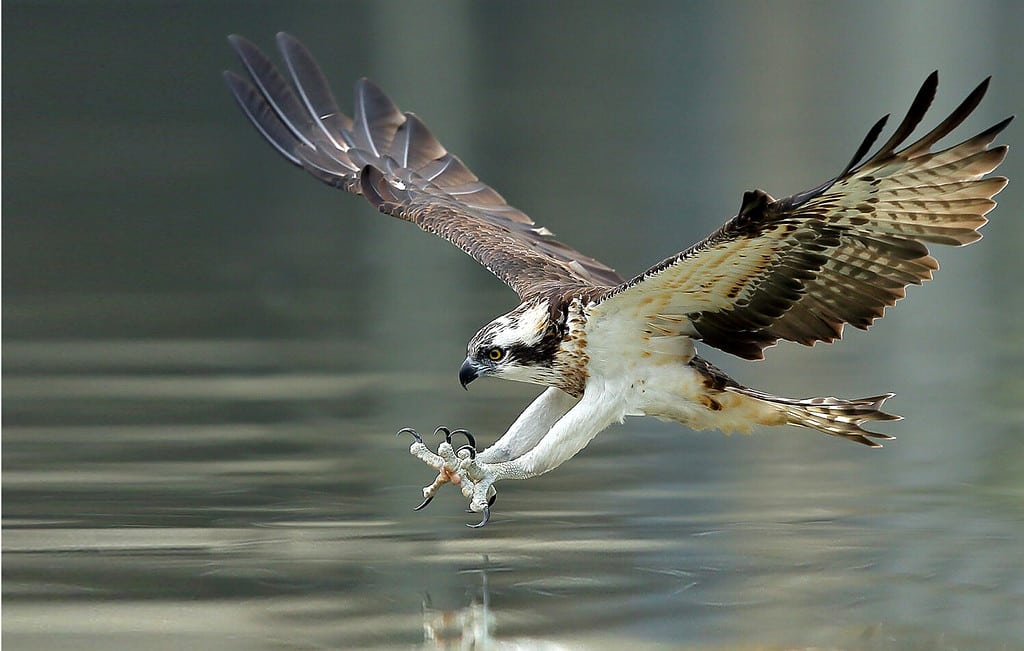
©Wang LiQiang/Shutterstock.com
| Measurement | Size |
|---|---|
| Length | 21 – 24 in (53 – 61 cm) |
| Weight | 3 to 4 pounds (1.8 kg) |
| Wingspan | 54 – 72 in (137 -183 cm) |
Ospreys, often called fish or sea hawks, are large, powerful birds that live near big waters almost everywhere except Antarctica. They have brown backs, white bellies, and an extraordinary brown streak near their eyes. What’s super neat about them is their feet: which are equipped with a reversible toe, allowing them to grip slippery fish super well. How they catch fish is amazing; they hover above the water, then dive in feet-first to grab their meal. If you’re in Louisiana, especially from August to April, you might see these skilled fishermen in action. It’s a must-watch!
17. Mallard (Anas platyrhynchos) — 20 to 24 inches
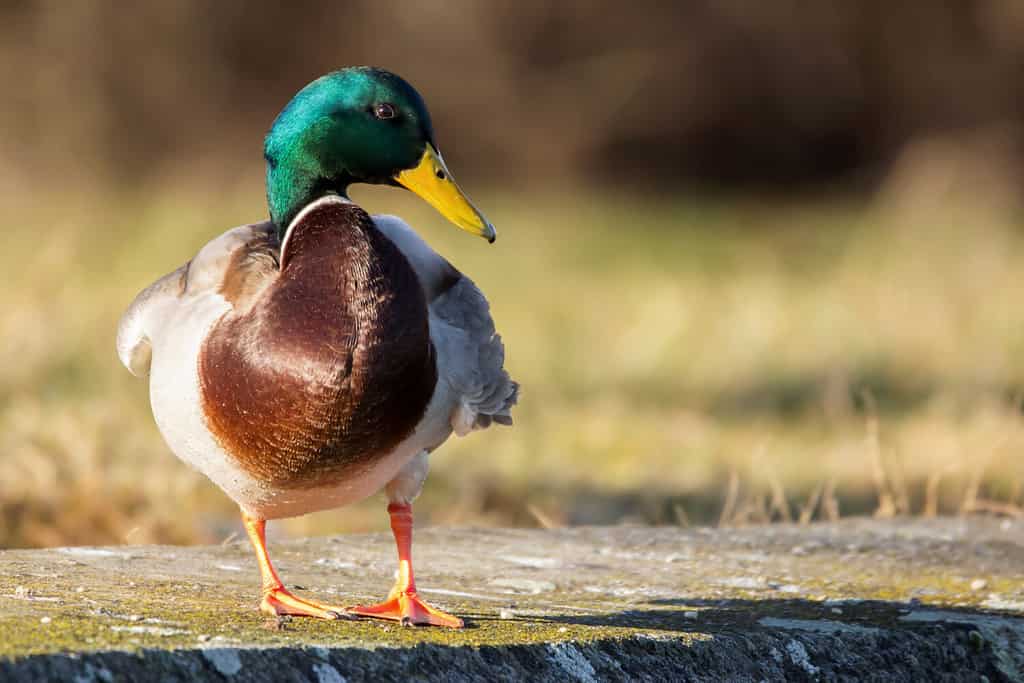
©Luka Hercigonja/Shutterstock.com
| Measurement | Size |
|---|---|
| Length | 20-24 in (51-62 cm) |
| Weight | 1.6 to 3.5 pounds (1.6 kg) |
| Wingspan | 32-39 in (81-98 cm) |
Mallards are one of the most common duck species in the world. So, chances are that you’ve probably seen around. The males, or “drakes,” have shiny green heads, yellow beaks, and cream bodies. On the other hand, the females, or “hens,” have a brown, camo-like pattern, which is super useful for hiding when they’re nesting.
These birds are everywhere, from freshwater to saltwater, and they munch on plants, seeds, and tiny bugs. Their varied diet and ability to adapt to different places make them popular worldwide. So, next time you see a duck at a park, there’s a good chance it’s a mallard!
18. Great Horned Owl (Bubo virginianus) — 18.1 to 24.8 inches

©iStock.com/makasana
| Measurement | Size |
|---|---|
| Length | 18.1 – 24.8 in (46 – 63 cm) |
| Weight | 32.1 – 88.2 oz (910 – 2500 g) |
| Wingspan | 39.8 – 57.1 in (101 – 145 cm) |
The great horned owl is an amazing large flying bird in Louisiana. These massive owls have “horn-like” tufts that are actually feathers on their heads, called “plumicorns.” Think of them as fake cat ears! This owl looks striking with a reddish face, white throat patch, and bright yellow eyes. While it’s night-time, this skilled hunter goes after small animals like rodents and even some bigger ones when it feels bold.
You can find this owl almost everywhere, from super cold Arctic areas to warm South America. It’s pretty impressive how they can live in so many places, proving they’re strong and adaptable.
Summary of the Largest Flying Birds in Louisiana
| Name of bird | Length | Weight | Wingspan | |
|---|---|---|---|---|
| 1 | American White Pelican | 60 – 63 in (152 – 160 cm) | 246.4 oz (6983 g) | 96 – 110 in (244 – 279 cm) |
| 2 | Mute Swan | 56 – 62 in (142 – 157 cm) | 416 oz (11789 g) | 84 – 96 in (213 – 244 cm) |
| 3 | Whooping Crane | 52 in (132 cm) | 204.8 oz (5804 g) | 87 in (221 cm) |
| 4 | Great Blue Heron | 46 – 52 in (117 – 132 cm) | 128 oz (3628 g) | 77 – 82 in (196 – 208 cm) |
| 5 | Brown Pelican | 48 – 50 in (122 – 127 cm) | 131.2 oz (3718 g) | 78 – 84 in (198 – 213 cm) |
| 6 | Wild Turkey | 43.3 – 45.3 in (110 – 115 cm) | 88.2 – 381.0 oz (2500 – 10800 g) | 49.2 – 56.7 in (125 – 144 cm) |
| 7 | Great Egret | 37 – 41 in (94 – 104 cm) | 59.96 oz (1699 g) | 54 – 55 in (137 – 140 cm) |
| 8 | Wood Stork | 35 – 45 in (89 – 114 cm) | 96 oz (2721 g) | 65 in (165 cm) |
| 9 | Sandhill Crane | 34 – 48 in (86 – 122 cm) | 132.27 oz (3749 g) | 73 – 90 in (185 – 229 cm) |
| 10 | Bald Eagle | 34 – 43 in (86 – 109 cm) | 168 oz (4761 g) | 72 – 96 in (183 – 244 cm) |
| 11 | Golden Eagle | 27 – 38 in (69 – 97 cm) | 160 oz (4534 g) | 72 – 96 in (183 – 244 cm) |
| 12 | Canada Goose | 25 – 45 in (64 – 114 cm) | 230.09 oz (6521 g) | 70 – 75 in (178 – 190 cm) |
| 13 | Turkey Vulture | 26 – 32 in (66 – 81 cm) | 51.2 oz (1451 g) | 68 – 72 in (173 – 183 cm) |
| 14 | Black Vulture | 23 – 27 in (58 – 69 cm) | 76.8 oz (2177 g) | 54 – 60 in (137 – 152 cm) |
| 15 | Crested Caracara | 20 – 25 in (51 – 64 cm) | 33.6 oz (952 g) | 45 – 48 in (114 – 122 cm) |
| 16 | Osprey | 21 – 24 in (53 – 61 cm) | 63.49 oz (1799 g) | 54 – 72 in (137 -183 cm) |
| 17 | Mallard | 20-24 in (51-62 cm) | 26.5-53 oz (750-1500 g) | 32-39 in (81-98 cm) |
| 18 | Great Horned Owl | 18.1 – 24.8 in (46 – 63 cm) | 32.1 – 88.2 oz (910 – 2500 g) | 39.8 – 57.1 in (101 – 145 cm) |









